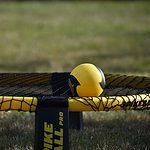Just as a master painter carefully selects their brushes, professional badminton players exercise great care in choosing their rackets—a choice that often becomes an extension of their playing arm. You might wonder what magic lies within the carbon fiber frames that grace the international courts.
From the Yonex Astrox 99 Pro, wielded by power players for its explosive energy transfer, to the Victor Auraspeed 90 K II, favored by those with lightning-fast reflexes, each racket is tailored to enhance specific aspects of a player's game. These high-caliber tools are not just about brand prestige; they are about meticulous engineering to suit the finesse, power, and agility required at the apex of the sport.
As you consider the pantheon of champion's rackets, think about how their choices could influence your own game. What secrets are they harboring, and how do they mold the very style and strategy of the players who entrust their victories to them? The answers lie within the nuances of each racket's design and the personal tales of those who bring them to life on the court.
Key Takeaways
- Elite players like Viktor Axelsen and Carolina Marin prefer rackets that offer power, control, and speed.
- Head-heavy rackets like Yonex Astrox 99 Pro and Victor Auraspeed 90 K II are popular among aggressive players.
- Yonex is the preferred brand for professional players, offering a blend of power and precision and a diverse range of rackets for different playing styles.
- Li-Ning and Dunlop also provide cutting-edge racket technology, offering unique features for power, control, and versatility.
Elite Players' Racket Choices
When choosing their weapons of the court, elite badminton players like Viktor Axelsen and Carolina Marin opt for rackets that deliver a formidable blend of power, control, and speed. You'll find them wielding head-heavy rackets, such as the Yonex Astrox 99 Pro and Victor Auraspeed 90 K II, which are tailored for aggressive and attacking play. These professional badminton rackets have specific characteristics, including a certain stiffness, a head-heavy balance, and a weight that typically hovers between 82-88 grams.
The Yonex Nanoflare 1000 Z, for instance, is engineered for extra speed and agility, making it a favorite among doubles players and agile female singles players like Marin. Your playing style, just like theirs, will heavily influence your choice of racket. It's not just about power; it's also about finding a racket that complements your technical skills and game strategies.
Whether you're drawn to the power-centric Victor Thruster F or the versatile Astrox 88D Pro Badminton racket, remember that each piece of equipment is a statement of your playing style. As you chase down shuttles and execute precise shots, your racket becomes an extension of your physical prowess and strategic mind.
Yonex: Preferred by Champions
Yonex rackets reign supreme among badminton champions, providing the perfect fusion of power and precision to match the high-octane demands of the sport's elite. When you're aiming for Olympic gold, every detail counts. That's why players like Carolina Marin opt for Yonex—precision-engineered to enhance their natural strengths. The Yonex Nanoflare 1000 Z, with its ability to offer extra speed and agility, complements Marin's aggressive, fast-paced play.
Here's why Yonex stands out:
- Astrox 99 Pro White**: Tailored for explosive strokes, the Astrox 99 Pro delivers unmatched control and power transfer, making it a favorite for those who play with unrelenting force.
- Innovation: Yonex consistently pushes the envelope with cutting-edge technology, ensuring their rackets meet the evolving needs of top-tier players.
- Diversity: Whether it's the all-around excellence of the Arcsaber 11 Pro Badminton racket or the specialized Nanoflare series for speed demons like Marin, Yonex offers a racket for every style.
- Legacy**: The brand's history of supporting champions—from the legendary Tai Tzu to current aces—speaks volumes about its commitment to excellence.
As you consider your options, trust that with a Yonex in hand, you're wielding a legacy of champions.
Victor's Top Models for Pros
While Yonex caters to many champions, Victor's top models, such as the Auraspeed 90 K II, Thruster Ryuga II, and JetSpeed S 12 II, are the rackets of choice for professional players like Anders Antonsen and Lee Zii Jia, offering a blend of stiffness and head-heavy balance that's essential for the pro game.
You should know that the Victor Auraspeed 90 K II is not just a mere racket; it's the embodiment of speed and precision, designed for players who pride themselves on fast playing styles and solid techniques. If you're aiming for powerful smashes, the Thruster Ryuga II is your go-to. Its stability and control are unparalleled, making it a favorite among pros who demand power in their play. Meanwhile, the JetSpeed S 12 II is the epitome of advanced engineering, promoting lightning-fast speed and comfortable hitting, all wrapped in a professional aesthetic.
Victor's best badminton rackets, including the Pro White Tiger and Thruster F C, are crafted to meet the demanding needs of the world's top players. Here's a quick comparison of these top-tier models:
| Model | Playing Style | Key Feature |
|---|---|---|
| Auraspeed 90 K II | Fast and Precise | Speed-Oriented Design |
| Thruster Ryuga II | Power and Control | Stability for Smashes |
| JetSpeed S 12 II | Fast and Comfort | Lightning-Fast Speed |
| Pro White Tiger | Aggressive Play | Head-Heavy Balance |
| Thruster F C | Versatile Use | All-Around Excellence |
Choose Victor, and you're opting for a racket that champions performance and innovation.
Li-Ning: Cutting-Edge Racket Technology
Just as Victor has established a strong presence in the professional badminton scene with its high-performance rackets, Li-Ning also brings to the table its own arsenal of cutting-edge racket technology designed to elevate your game to new heights. Unlike the Yonex Nanoflare or the Astrox 100 ZZ, Li-Ning rackets are engineered with a unique blend of features that cater to your need for both power and control.
Here's what sets Li-Ning rackets apart:
- FREE CORE Technology: Li-Ning's innovative FREE CORE technology offers enhanced precision, allowing you to deliver more accurate shots without compromising on power.
- Dynamic Weight Distribution: The head heavy balance of Li-Ning rackets, similar to the Astrox 100 ZZ, provides a powerful swing, making it easier to generate shuttle speed.
- Enhanced Sweet Spot: Li-Ning rackets boast an enlarged sweet spot, which means even off-center hits can still result in strong, controlled shots.
- Aerodynamic Frame Design: The sleek frame minimizes air resistance, much like the Yonex Nanoflare 1000 Z, allowing for faster swings and quick maneuverability.
When you're on the court, it's not just about having a racket; it's about the seamless integration of technology that complements your style of play. Li-Ning rackets deliver just that — stability, control, and the power you need to dominate the game.
Dunlop: Power and Precision
Harnessing the fusion of power and precision, the Dunlop badminton racket stands out as an exceptional choice for players aiming to control the court with forceful smashes and pinpoint accuracy. You'll find that this racket caters to your ambitious style, especially if you're someone who thrives on aggressive play. The design is meticulously crafted to ensure that you can deliver both powerful and accurate shots, a combination that's crucial for advanced badminton dynamics.
For doubles players who need to switch swiftly from defense to attack, the Dunlop racket offers the versatility to command the play effectively. You're not just looking for a tool to hit the shuttle; you're seeking an extension of your strategic intent. This racket is a top pick among the best players who understand that winning is about mastering all styles of play.
Whether you're volleying for a delicate drop shot or powering through for a cross-court smash, the Dunlop: Power and Precision racket provides the stability and responsiveness you demand. For players looking to elevate their game, this racket is a beacon of excellence, blending the raw energy of powerful strokes with the finesse required for surgical shot placement.
Racket Features Pros Love
Building on the fusion of power and precision exemplified by Dunlop rackets, professional players often have specific preferences that dictate their choice in equipage, favoring features that enhance their unique playing styles. You're likely aware that the best rackets combine several key characteristics to meet the high demands of the sport. Here's what the pros love:
- Head-Heavy Balance: The Yonex Astrox 99 Pro badminton racket exemplifies this, tailored for explosive power. The head-heavy design allows you to hit with formidable strength, as seen with Viktor Axelsen's aggressive play.
- Stiff Flexibility: Pro badminton rackets like the Victor Auraspeed 90 K II offer stiff shafts, ensuring minimal energy loss during fast swings, catering to players with a rapid style and precise technique.
- Stability and Control: A racket like the Victor Thruster Ryuga II, chosen by Lee Zii Jia, provides the stability needed for an attacking game, without sacrificing the control required for meticulous shot placement.
- Speed and Agility: The Yonex Nanoflare 1000 Z, featuring a Grayish Pearl color, is designed for swift racket movement, crucial for doubles specialists and agile singles players like Carolina Marin.
Each racket is designed with the player in mind, allowing you to hit your peak performance on the court.
Brand Sponsorships and Player Performance
Brand sponsorships play a pivotal role in not only equipping professional badminton players with the latest racket technology but also in influencing the sport's innovation and competitive dynamics. When you're playing badminton at the highest level, the quality of your pro badminton racket can significantly impact your player performance. The world's best singles players and doubles specialists alike depend on rackets that amplify their natural talents and support their unique playing styles.
Top-tier players like Viktor Axelsen and Anders Antonsen have brand sponsorships that ensure they wield rackets providing the perfect blend of power and control. The head heavy design favored by these athletes facilitates stability and power, crucial for dominating the court. Similarly, Carolina Marin's Yonex Nanoflare 1000 Z is tailored for her aggressive play, offering the speed and agility needed to outmaneuver opponents.
The rackets used by professionals are meticulously designed to enhance features such as smashing power and shot speed while reducing air resistance for better repulsion. This attention to detail means that whether you're at the net or the rear court, you have a tool that complements your skills.
In essence, the relationship between brand sponsorships and player performance is symbiotic. The right racket becomes an extension of the player, turning each match into a showcase of precision engineering and athletic prowess.
Upgrading Your Game: Pro Racket Insights
Understanding the symbiotic relationship between brand sponsorships and player performance can guide you in selecting a pro racket that elevates your game to the next level. When you're ready to invest in upgrading your game, it's crucial to look at what the pros are using. Their choices in badminton rackets are often the result of meticulous selection and brand partnerships, ensuring they've the best tools to match their playing style and enhance their performance.
Here are some insights to consider when selecting a pro racket:
- Power and Precision: Choose a racket like the Yonex Astrox 99 Pro, favored for its head heavy design, if your game strategy involves explosive strokes and power transfer.
- Stiff Flexibility: For an attacking play style akin to Viktor Axelsen's, the Yonex Astrox 100 ZZ offers the stiff flexibility you need.
- Speed and Technique: Consider the Victor Auraspeed 90 K II for a fast-paced game that requires solid technique, just as Anders Antonsen.
- Stability and Control: If you're seeking a balance between power and control, Lee Zii Jia's choice, the Victor Thruster Ryuga II, might suit you.
Make sure you're picking the best racket on the market that aligns with the demands of your evolving skills and playing strategy.





